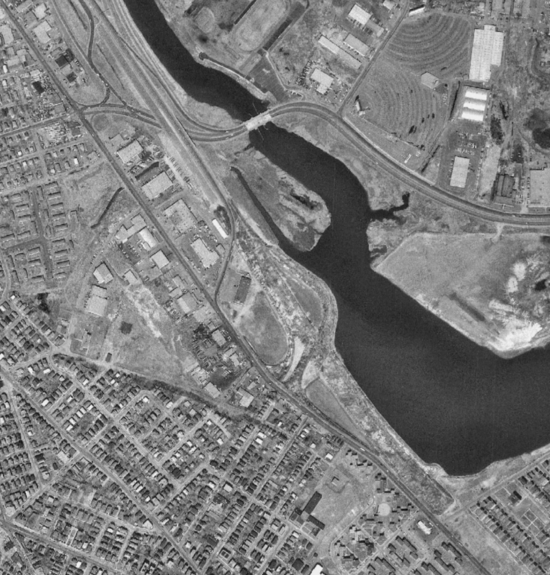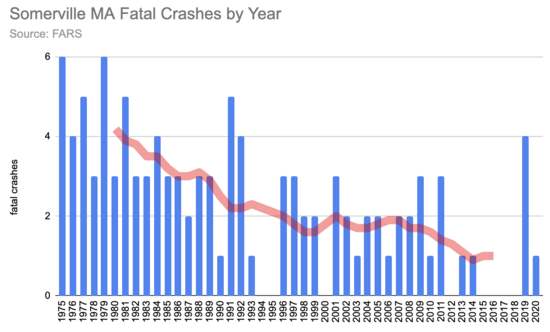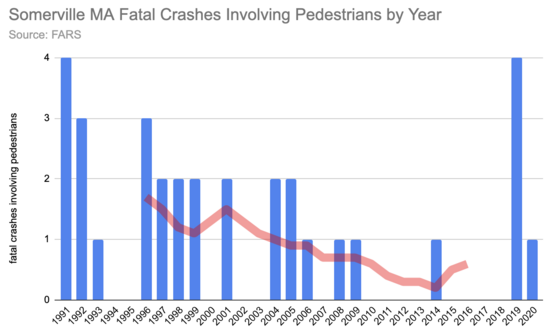Somerville Roads Getting More Dangerous?
post by jefftk (jkaufman) · 2023-02-23T18:20:03.354Z · LW · GW · 1 commentsContents
1 comment
In a local discussion of whether our attempts to reduce traffic fatalities were working someone posted:
I've lived in Somerville for over 40 years and have visited even longer. The roads are more dangerous than ever.
With all the Vision Zero work, and earlier traffic safety progress, this would be surprising and disappointing if it were the case. Is it?
Somerville is an interesting city to look at because it was mostly built out decades ago. The last large change was bulldozing I-93 through in the late 1960s:
This makes fatality rates over time comparable in a way they wouldn't be if you were looking at a city that had expanded, contracted, or been seriously rebuilt.
I pulled accident date from the national Fatality Analysis Reporting System (FARS) which goes back to 1975. Here's what I see for the number of fatal crashes annually (code):
blue bars are annual counts; red line is a 10y centered moving average
Over the last 40y it's gotten about 3x better, though 2019 was a pretty bad year.
I'd also be interested in whether our roads are becoming more dangerous for pedestrians specifically. Is the decrease just due to airbags, crash testing, and cars becoming safer for their occupants? While pedestrian data in FARS only goes back to 1991, we can still graph what we have:
It does look like we're making progress specifically within pedestrian safety as well, though 2019 now sticks out even more.
(I'm being lazy here and charting "traffic accidents with a fatality and involving at least one pedestrian". The FARS data does make it possible to see whether it was a pedestrian that died, but this requires joining CSVs in a way that's a bit awkward. In the ones I've spot checked the fatality was a pedestrian, which is what you'd expect.)
Comment via: facebook, mastodon
1 comments
Comments sorted by top scores.
comment by mad · 2023-02-23T22:52:55.493Z · LW(p) · GW(p)
I'm a traffic engineer and this sort of thing is more or less my area of expertise. I feel weird posting "I have nothing to add, seems legit" but I feel like if I wrote a blog post like this as a layman I'd like to know I wasn't completely off my rocker.
My only suggestion would be if the data allows you to also get "serious injuries" - those are a bit less variable than fatalities and will be able to give you a better picture of the trend, because there's also going to be more of them.
I used to do fatal crash investigation, and fatalities can be very random. You hear about horrific car crashes at high speeds where everyone walks away without a scratch. What you don't hear about is the sort of crash I attended once: a tiny, slow crash on a back road at a low speed, where two cars hit each other at a small suburban intersection. Barely any damage to the cars. No sign of the crash on the road or the vicinity (fatal crashes often have damaged vegetation, marks on the road, etc). But one of the passengers was an 84 year old woman and that crash was more than her body could take. If she hadn't been in the car, there would probably have been zero fatalities in that crash. I saw another similar crash with a man in his 80s.
That was what surprised me the most about doing fatal crash investigation: I was expecting there to be men in their 20s and 30s who were drunk or high. I wasn't expecting the number of suicides but it didn't surprise me. But the number of "old people" who died, I hadn't expected that even though it's so obvious in retrospect.
But yeah, that sort of thing is why I think "serious injuries" or "hospitalisations" might be a better metric for you: there will be 10-100x more of them so the trend will be less noisy.


